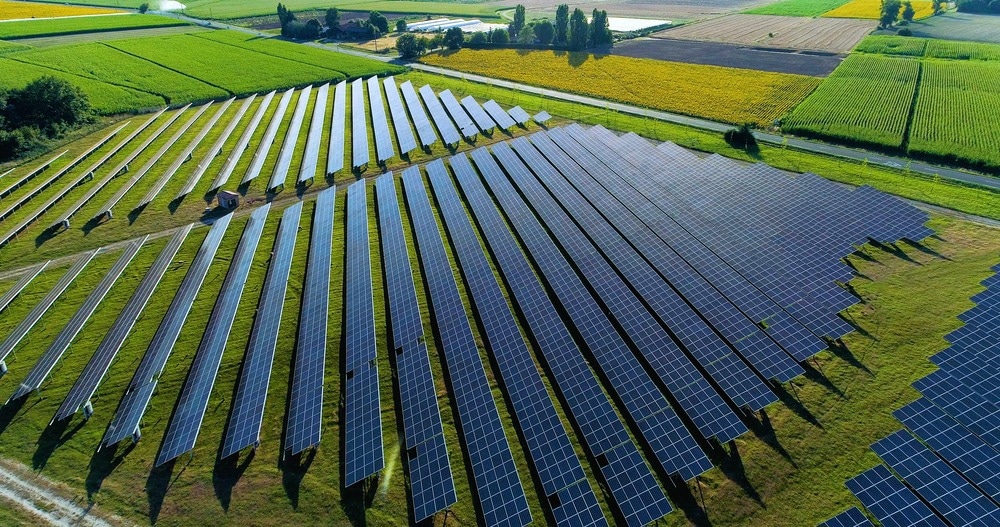Hyper-doped silicon solar cells have low photo-generated charge-carrier collection issues and poor open-circuit voltage (VOC) for a sub-bandgap optoelectronic response. According to a study published recently in Optics and Laser technology, a team of researchers deposited (Si/Ti) multilayer films on the surface of monocrystalline silicon solar cells with a single p/n junction.

Study: Laser hyperdoping of silicon films for sub-bandgap photoconversion enhancement. Image Credit: Fly_and_Dive/Shutterstock.com
The researchers used a 1064-nm nanosecond-pulsed laser to melt the films and crystallize them into titanium-hyper-doped silicon (Si: Ti) films. Sub-bandgap and above-bandgap photocurrents of solar cells can be boosted by increasing sub-bandgap infrared absorption, decreasing light reflection, and using a p/n/n+ junction for charge-carrier collection.
Photo-Conversion Efficiency (PCE) of Silicon
Silicon is a crucial component in optoelectronics owing to its superior quality and established micro-processing technology.
Silicon single-junction solar cells have a theoretical maximum photo-conversion efficiency (PCE) of 29.1% when accounting for optical loss resulting from its bandgap of 1.12 eV, resistive loss, and extrinsic recombination loss. The practical PCE of an amorphous silicon heterojunction solar cell can achieve 26.3% by accumulating the light with a minimal current loss and the photo-generated charge carriers with less power loss.
Strategy to Enhance the PCE of Silicon
Singlet exciton of tetracene creates two triplet excitons to stimulate two electron-hole pairs in silicon, enhancing the PCE to 35%. Sub-bandgap infrared absorption of 1200–2500 nm wavelength can be added to the inherent optical absorption of silicon through deep-level hyper-doping, resulting in the formation of an impurity band (IB) in the valance band of silicon. The full solar spectral area (λ = 200–2500 nm) can also be included in the optoelectronic response range of silicon to raise the PCE limit to 54.8%.
Deep-Level Hyper-Doped Silicon Heterojunction
Monocrystalline silicon is typically subjected to ion implantation or femtosecond (fs) laser irradiation with transition-metal or chalcogen impurities to produce deep-level hyper-doped Silicon heterojunctions. Hyper-doped Si layer is produced on a monocrystalline Si substrate to create a p/n+ structure.
Limitations of Hyper-Doped Si Solar Cell
The primary issue with hyper-doped silicon solar cells is the occurrence of surface recombination or Auger recombination during fabrication, which results in inadequate open-circuit voltage (VOC) or short-circuit current density (JSC). Such recombinations can be effectively resolved by surface anisotropic etching, light and shallow doping, or conformal passivation layer. However, excessive doping results in lower sub-bandgap infrared absorption.
The key to enhancing device performance is optimizing the electron charge, charge-carrier lifespan, charge-carrier mobility, and sub-bandgap absorptivity while considering the merit of sub-bandgap devices. Deep-level impurities such as chalcogen (S, Se, and Te) and transition-metal elements must be added in quantities that are considerably above the equilibrium solid solubility limit of silicon to produce hyper-doped silicon heterojunctions. This results in a poor collection of the photo-generated charge carriers and a short diffusion length. It is challenging to separate, collect, and transport electron-hole pairs in hyper-doped silicon solar cells.
Development of Titanium Hyper-Doped Silicon
Titanium is a better candidate for silicon donor than sulfur. Titanium displays a sub-bandgap infrared response in titanium hyper-doped Silicon (Si: Ti). Yang et al. successfully hyper-doped monocrystalline silicon with titanium using the nanosecond (ns)-laser melting process in this research.
(Si/Ti) multilayer films were formed on a monocrystalline silicon solar cell substrate to address the challenges faced by the solar cell. When such films are used to produce the p/n junction directly, it is possible to avoid the low charge-carrier collection and poor VOC. The primary p-n junction of the substrate and the n+-n junction created between the Si:Ti sheets and substrate can absorb the incident photons and convert them into photocurrent.
Research Findings
The newly developed Si:Ti solar cell successfully transported, separated, and collected sub-bandgap infrared electron-hole pairs. Si:Ti coatings created a rough surface and enhanced light trapping.
The p/n/n+ structure of solar cells favored charge carrier collection and reduced electron-hole recombination, which enhanced the device's photocurrent. The VOC was also enhanced by the p/n/n+ structure, which also added the sub-bandgap photocurrent to the above-bandgap photocurrent.
By utilizing a higher-performance Si solar cell substrate and streamlining the fabrication process, the PCE of this solar cell can be further enhanced. From the standpoint of industrial use, the structure of these hyper-doped Si solar cells has a flexible selection of deep-level dopant and substrate types, a controllable hyper doping concentration and thickness, and a straightforward production procedure.
Reference
Yang, Y. J., Cai, X. D., Yang, H. W., Shi, Z. Q., Wen, C., Liu, L., Yang, W. B., & Zhang, L. C. (2022). Laser hyperdoping of silicon films for sub-bandgap photoconversion enhancement. Optics & Laser Technology, 156, 108583. https://www.sciencedirect.com/science/article/pii/S0030399222007320
Disclaimer: The views expressed here are those of the author expressed in their private capacity and do not necessarily represent the views of AZoM.com Limited T/A AZoNetwork the owner and operator of this website. This disclaimer forms part of the Terms and conditions of use of this website.